Monitoring Dark-State Dynamics of a Single Nitrogen-Vacancy Center in Nanodiamond by Auto-Correlation Spectroscopy: Photonionization and Recharging
Abstract
1. Introduction
2. Theory
3. Results and Discussion
3.1. Selective Charge Ionization of Single NV Centers upon Excitation
3.2. The Ionization/Recharging Process of Single NV Centers Is Power-Dependent
3.3. The Autocorrelation Extracts the Transition Time of Multiple States
4. Conclusions
5. Materials and Methods
5.1. Preparation of the Nanodiamond
5.2. Time-Resolved Spectroscopy
Author Contributions
Funding
Acknowledgments
Conflicts of Interest
References
- Alexios Beveratos, R.B.; Gacoin, T.; Villing, A.; Grangier, J.-P.; Grangier, P. Single Photon Quantum Cryptography. Phys. Rev. Lett. 2002, 89, 187901. [Google Scholar] [CrossRef] [PubMed]
- Kurtsiefer, C.; Mayer, S.; Zarda, P.; Weinfurter, H. Stable Solid-State Source of Single Photons. Phys. Rev. Lett. 2000, 85, 290–293. [Google Scholar] [CrossRef] [PubMed]
- Le Sage, D.; I Arai, K.; Glenn, D.R.; DeVience, S.J.; Pham, L.M.; Rahnlee, L.; Lukin, M.D.; Yacoby, A.; Komeili, A.; Walsworth, R.L. Optical magnetic imaging of living cells. Nat. Cell Biol. 2013, 496, 486–489. [Google Scholar] [CrossRef] [PubMed]
- Dolde, F.; Fedder, H.; Doherty, M.W.; Nobauer, T.; Rempp, F.; Balasubramanian, G.; Wolf, T.; Reinhard, F.; Hollenberg, L.C.L.; Jelezko, F.; et al. Electric-field sensing using single diamond spins. Nat. Phys. 2011, 7, 459–463. [Google Scholar] [CrossRef]
- Bradac, C.; Gaebel, T.; Naidoo, N.; Sellars, M.J.; Twamley, J.; Brown, L.J.; Barnard, A.S.; Plakhotnik, T.; Zvyagin, A.V.; Rabeau, J.R. Observation and control of blinking nitrogen-vacancy centres in discrete nanodiamonds. Nat. Nanotechnol. 2010, 5, 345–349. [Google Scholar] [CrossRef]
- Ivanov, I.P.; Li, X.; Dolan, P.R.; Gu, M. Nonlinear absorption properties of the charge states of nitrogen-vacancy centers in nanodiamonds. Opt. Lett. 2013, 38, 1358–1360. [Google Scholar] [CrossRef]
- Kuo, Y.; Hsu, T.-Y.; Wu, Y.-C.; Chang, H.-C. Fluorescent nanodiamond as a probe for the intercellular transport of proteins in vivo. Biomaterials 2013, 34, 8352–8360. [Google Scholar] [CrossRef]
- Wilson, E.R.; Parker, L.M.; Orth, A.; Nunn, N.; Torelli, M.D.; Shenderova, O.; Gibson, B.C.; Reineck, P. The effect of particle size on nanodiamond fluorescence and colloidal properties in biological media. Nanotechnology 2019, 30, 385704. [Google Scholar] [CrossRef]
- Monticone, D.G.; Katamadze, K.; Traina, P.; Moreva, E.; Forneris, J.; Ruo-Berchera, I.; Olivero, P.; DeGiovanni, I.P.; Brida, G.; Genovese, M. Beating the Abbe Diffraction Limit in Confocal Microscopy via Nonclassical Photon Statistics. Phys. Rev. Lett. 2014, 113, 143602. [Google Scholar] [CrossRef]
- Chen, E.H.; Gaathon, O.; Trusheim, M.E.; Englund, D. Wide-Field Multispectral Super-Resolution Imaging Using Spin-Dependent Fluorescence in Nanodiamonds. Nano Lett. 2013, 13, 2073–2077. [Google Scholar] [CrossRef]
- Johnstone, G.E.; Cairns, G.S.; Patton, B.R. Nanodiamonds enable adaptive-optics enhanced, super-resolution, two-photon excitation microscopy. R. Soc. Open Sci. 2019, 6, 190589. [Google Scholar] [CrossRef]
- Arroyo-Camejo, S.; Adam, M.-P.; Besbes, M.; Hugonin, J.-P.; Jacques, V.; Greffet, J.-J.; Roch, J.-F.; Hell, S.W.; Treussart, F. Stimulated Emission Depletion Microscopy Resolves Individual Nitrogen Vacancy Centers in Diamond Nanocrystals. ACS Nano 2013, 7, 10912–10919. [Google Scholar] [CrossRef]
- Michler, P.; Imamoğlu, A.; Mason, M.D.; Carson, P.J.; Strouse, G.F.; Buratto, S.K. Quantum correlation among photons from a single quantum dot at room temperature. Nat. Cell Biol. 2000, 406, 968–970. [Google Scholar] [CrossRef]
- Steiner, M.; Hartschuh, A.; Korlacki, R.; Meixner, A.J. Highly efficient, tunable single photon source based on single molecules. Appl. Phys. Lett. 2007, 90, 183122. [Google Scholar] [CrossRef]
- Siyushev, P.; Pinto, H.; Vörös, M.; Gali, A.; Jelezko, F.; Wrachtrup, J. Optically controlled switching of the charge state of a single nitrogen-vacancy center in diamond at cryogenic temperatures. Phys. Rev. Lett. 2013, 110, 167402. [Google Scholar] [CrossRef] [PubMed]
- Waldherr, G.; Beck, J.; Steiner, M.; Neumann, P.; Gali, A.; Frauenheim, T.; Jelezko, F.; Wrachtrup, J. Dark States of Single Nitrogen-Vacancy Centers in Diamond Unraveled by Single Shot NMR. Phys. Rev. Lett. 2011, 106, 157601. [Google Scholar] [CrossRef] [PubMed]
- Beha, K.; Batalov, A.; Manson, N.B.; Bratschitsch, R.; Leitenstorfer, A. Optimum Photoluminescence Excitation and Recharging Cycle of Single Nitrogen-Vacancy Centers in Ultrapure Diamond. Phys. Rev. Lett. 2012, 109, 097404. [Google Scholar] [CrossRef] [PubMed]
- Stevenson, R.M.; Young, R.J.; Atkinson, P.; Cooper, K.; Ritchie, D.A.; Shields, A.J. A semiconductor source of triggered entangled photon pairs. Nat. Cell Biol. 2006, 439, 179–182. [Google Scholar] [CrossRef]
- Aharonovich, I.; Greentree, A.D.; Prawer, S. Diamond photonics. Nat. Photon. 2011, 5, 397–405. [Google Scholar] [CrossRef]
- Vlasov, I.I.; Shiryaev, A.A.; Rendler, T.; Steinert, S.; Lee, S.Y.; Antonov, D.; Vörös, M.; Jelezko, F.; Fisenko, A.V.; Semjonova, L.F.; et al. Molecular-sized fluorescent nanodiamonds. Nat. Nanotechnol. 2014, 9, 54–58. [Google Scholar] [CrossRef] [PubMed]
- Stehlik, S.; Varga, M.; Ledinsky, M.; Miliaieva, D.; Kozak, H.; Skakalova, V.; Mangler, C.; Pennycook, T.J.; Meyer, J.C.; Kromka, A.; et al. High-yield fabrication and properties of 1.4 nm nanodiamonds with narrow size distribution. Sci. Rep. 2016, 6, 38419. [Google Scholar] [CrossRef] [PubMed]
- Bradac, C.; Gaebel, T.; Pakes, C.I.; Say, J.M.; Zvyagin, A.V.; Rabeau, J.R. Effect of the Nanodiamond Host on a Nitrogen-Vacancy Color-Centre Emission State. Small 2013, 9, 132–139. [Google Scholar] [CrossRef] [PubMed]
- Aslam, N.; A Waldherr, G.; Neumann, P.J.; Jelezko, F.; Wrachtrup, J. Photo-induced ionization dynamics of the nitrogen vacancy defect in diamond investigated by single-shot charge state detection. New J. Phys. 2013, 15. [Google Scholar] [CrossRef]
- Chen, X.-D.; Zou, C.-L.; Sun, F.-W.; Guo, G.-C. Optical manipulation of the charge state of nitrogen-vacancy center in diamond. Appl. Phys. Lett. 2013, 103, 013112. [Google Scholar] [CrossRef]
- Manson, N.; Harrison, J. Photo-ionization of the nitrogen-vacancy center in diamond. Diam. Relat. Mater. 2005, 14, 1705–1710. [Google Scholar] [CrossRef]
- Löfgren, R.; Öberg, S.; Larsson, J.A. A theoretical study of de-charging excitations of the NV-center in diamond involving a nitrogen donor. New J. Phys. 2020, 22, 123042. [Google Scholar] [CrossRef]
- Garcia-Parajo, M.F.; Segers-Nolten, G.M.J.; Veerman, J.-A.; Greve, J.; Van Hulst, N.F. Real-time light-driven dynamics of the fluorescence emission in single green fluorescent protein molecules. Proc. Natl. Acad. Sci. USA 2000, 97, 7237–7242. [Google Scholar] [CrossRef]
- Widengren, J.; Mets, U.; Rigler, R. Fluorescence Correlation Spectroscopy of Triplet States in Solution: A Theoretical and Experimental Study. J. Phys. Chem. 1995, 99, 13368–13379. [Google Scholar] [CrossRef]
- Schwille, P.; Kummer, S.; Heikal, A.A.; Moerner, W.E.; Webb, W.W. Fluorescence correlation spectroscopy reveals fast optical excitation-driven intramolecular dynamics of yellow fluorescent proteins. Proc. Natl. Acad. Sci. USA 2000, 97, 151–156. [Google Scholar] [CrossRef]
- Liu, J.; Irudayaraj, J. Second harmonic generation correlation spectroscopy for single molecule experiments. Opt. Express 2013, 21, 27063–27073. [Google Scholar] [CrossRef] [PubMed]
- Vidi, P.-A.; Liu, J.; Salles, D.; Jayaraman, S.; Dorfman, G.; Gray, M.; Abad, P.; Moghe, P.V.; Irudayaraj, J.M.; Wiesmüller, L.; et al. NuMA promotes homologous recombination repair by regulating the accumulation of the ISWI ATPase SNF2h at DNA breaks. Nucleic Acids Res. 2014, 42, 6365–6379. [Google Scholar] [CrossRef] [PubMed]
- Moreno, N.S.; Liu, J.; Haas, K.M.; Parker, L.L.; Chakraborty, C.; Kron, S.J.; Hodges, K.; Miller, L.D.; Langefeld, C.; Robinson, P.J.; et al. The nuclear structural protein NuMA is a negative regulator of 53BP1 in DNA double-strand break repair. Nucleic Acids Res. 2019, 47, 2703–2715. [Google Scholar] [CrossRef] [PubMed]
- Jabri, H.; Eleuch, H.; Djerad, T. Lifetimes of atomic Rydberg states by autocorrelation function. Laser Phys. Lett. 2005, 2, 253–257. [Google Scholar] [CrossRef]
- Jungwirth, N.R.; Pai, Y.Y.; Chang, H.S.; MacQuarrie, E.R.; Nguyen, K.X.; Fuchs, G.D. A single-molecule approach to ZnO defect studies: Single photons and single defects. J. Appl. Phys. 2014, 116, 043509. [Google Scholar] [CrossRef]
- Liu, J.; Hu, Y.; Kumar, P.; Liu, X.; Irudayaraj, J.M.K.; Cheng, G.J. Enhanced Energy Transfer from Nitrogen-Vacancy Centers to Three-Dimensional Graphene Heterostructures by Laser Nanoshaping. Adv. Opt. Mater. 2021, 2001830. [Google Scholar] [CrossRef]
- Liu, J.; Kumar, P.; Hu, Y.; Cheng, G.J.; Irudayaraj, J. Enhanced Multiphoton Emission from CdTe/ZnS Quantum Dots Decorated on Single-Layer Graphene. J. Phys. Chem. C 2015, 119, 6331–6336. [Google Scholar] [CrossRef]
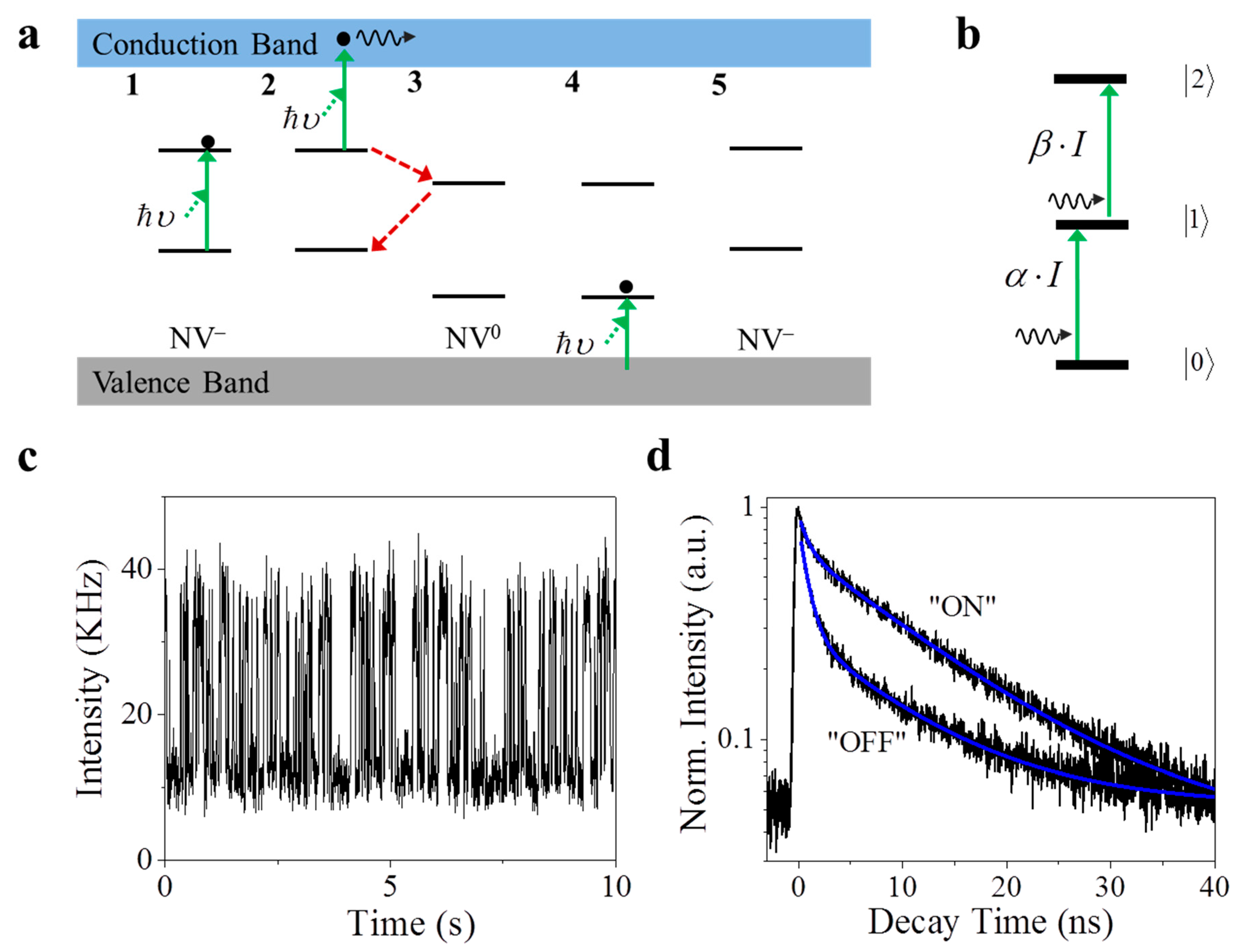
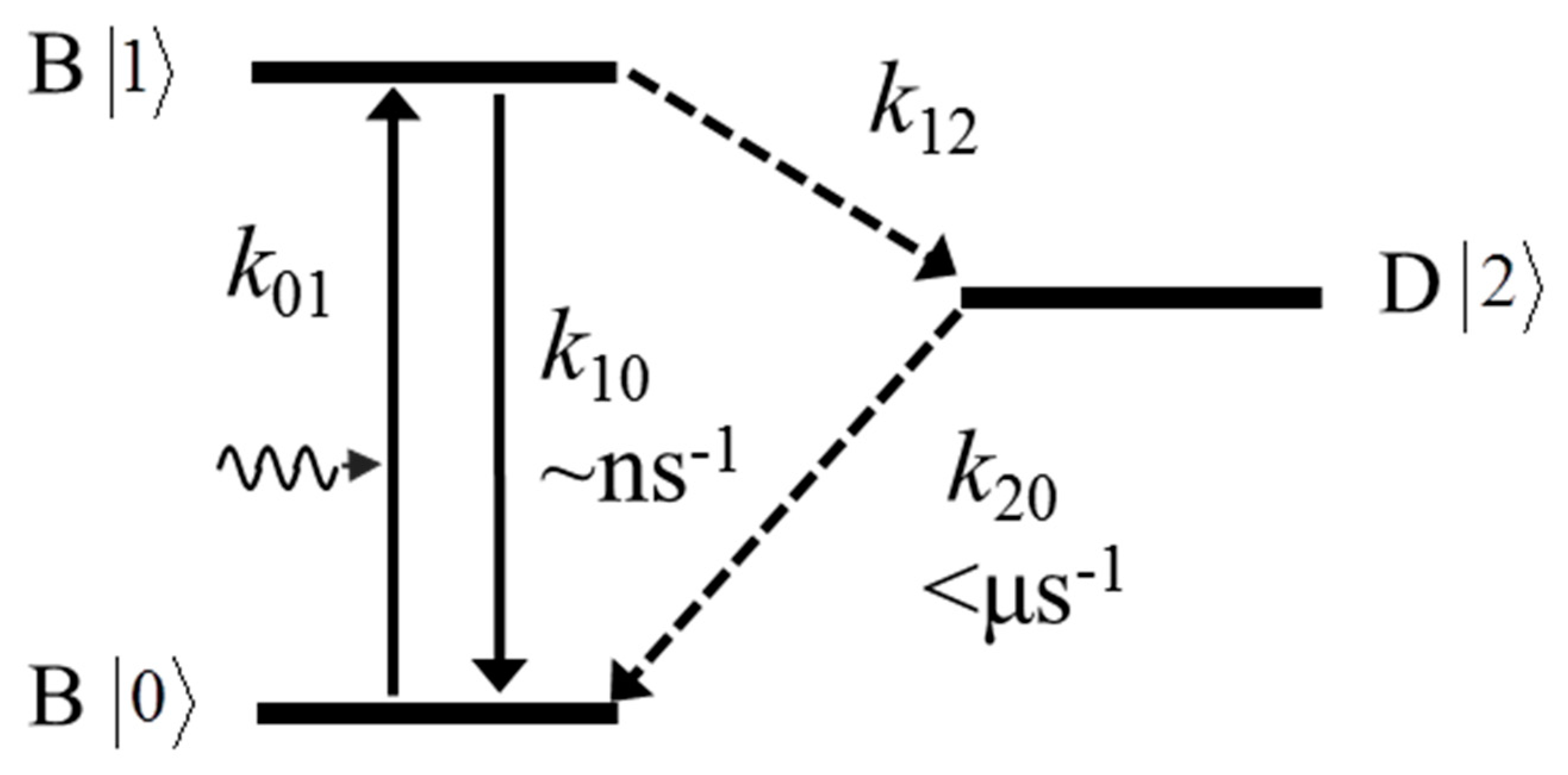
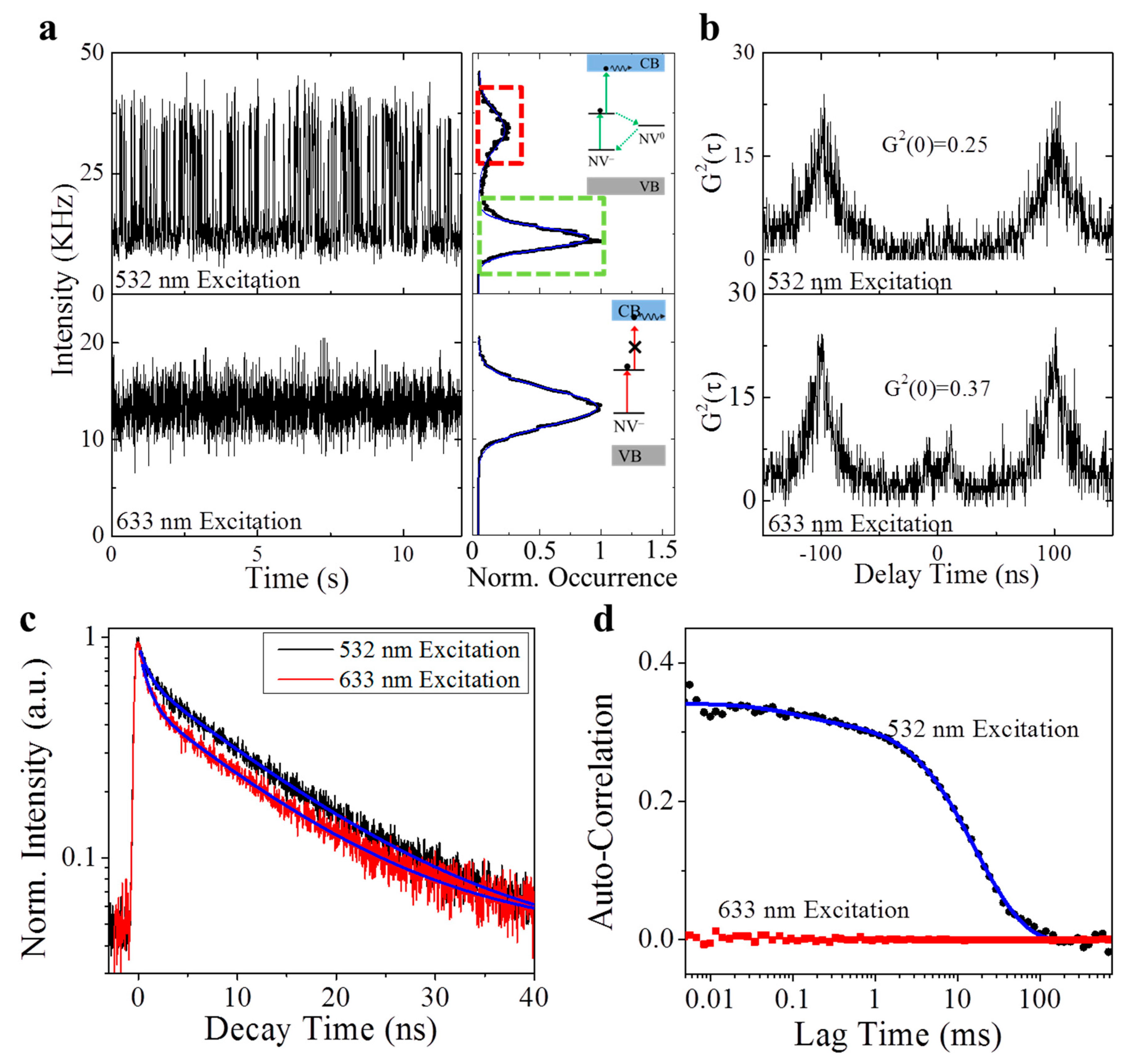
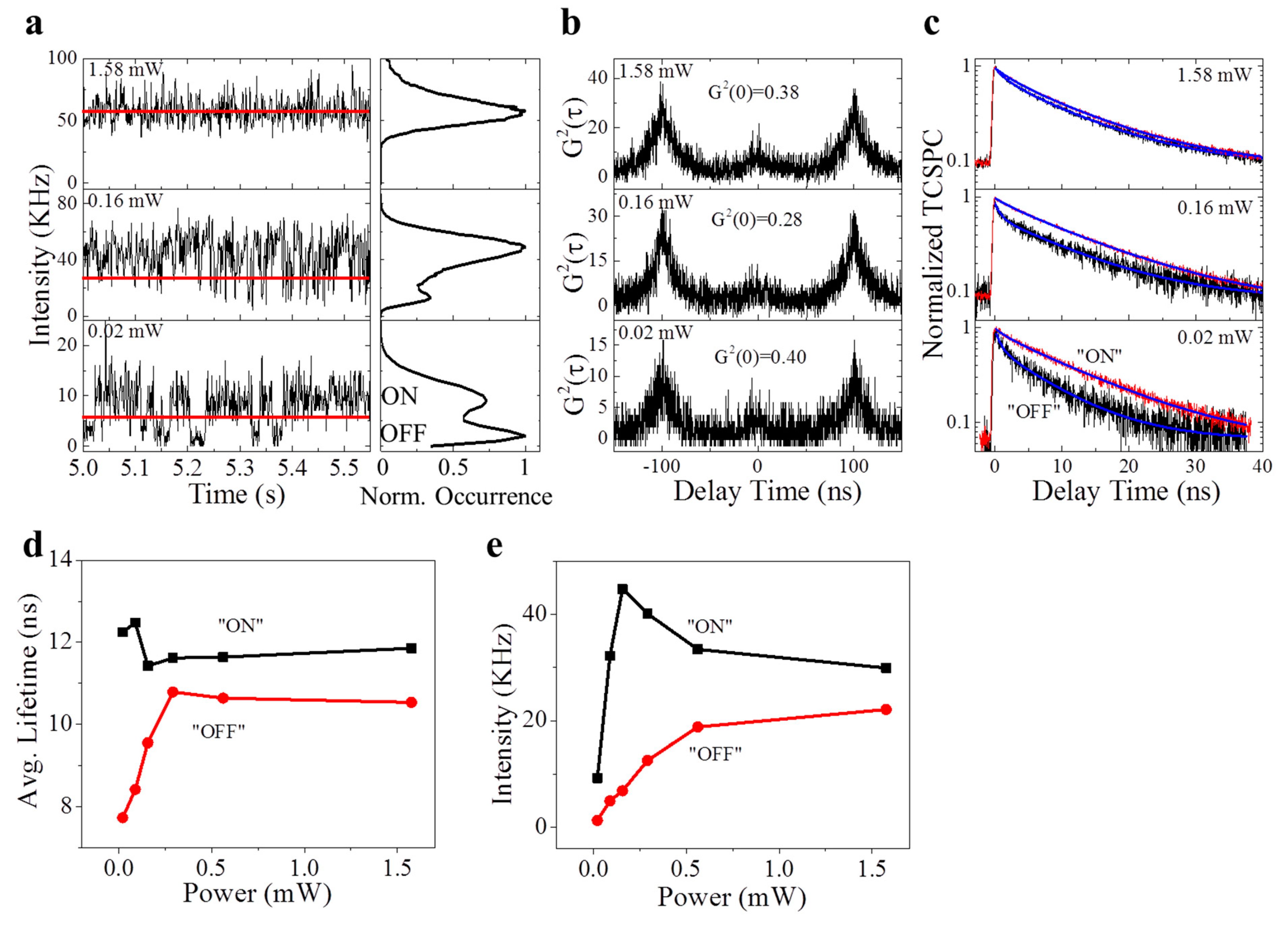
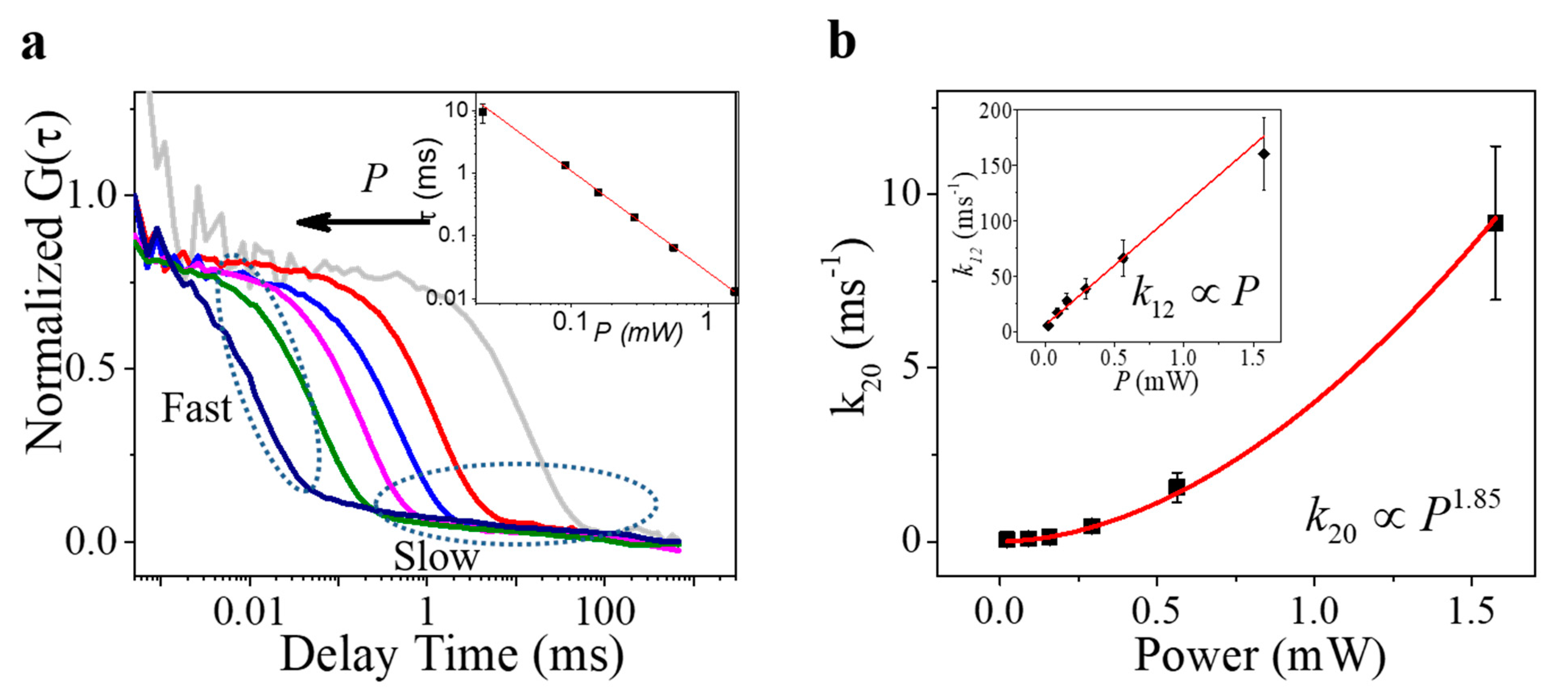

Publisher’s Note: MDPI stays neutral with regard to jurisdictional claims in published maps and institutional affiliations. |
© 2021 by the authors. Licensee MDPI, Basel, Switzerland. This article is an open access article distributed under the terms and conditions of the Creative Commons Attribution (CC BY) license (https://creativecommons.org/licenses/by/4.0/).
Share and Cite
Zhang, M.; Li, B.-Y.; Liu, J. Monitoring Dark-State Dynamics of a Single Nitrogen-Vacancy Center in Nanodiamond by Auto-Correlation Spectroscopy: Photonionization and Recharging. Nanomaterials 2021, 11, 979. https://doi.org/10.3390/nano11040979
Zhang M, Li B-Y, Liu J. Monitoring Dark-State Dynamics of a Single Nitrogen-Vacancy Center in Nanodiamond by Auto-Correlation Spectroscopy: Photonionization and Recharging. Nanomaterials. 2021; 11(4):979. https://doi.org/10.3390/nano11040979
Chicago/Turabian StyleZhang, Mengdi, Bai-Yan Li, and Jing Liu. 2021. "Monitoring Dark-State Dynamics of a Single Nitrogen-Vacancy Center in Nanodiamond by Auto-Correlation Spectroscopy: Photonionization and Recharging" Nanomaterials 11, no. 4: 979. https://doi.org/10.3390/nano11040979
APA StyleZhang, M., Li, B.-Y., & Liu, J. (2021). Monitoring Dark-State Dynamics of a Single Nitrogen-Vacancy Center in Nanodiamond by Auto-Correlation Spectroscopy: Photonionization and Recharging. Nanomaterials, 11(4), 979. https://doi.org/10.3390/nano11040979





